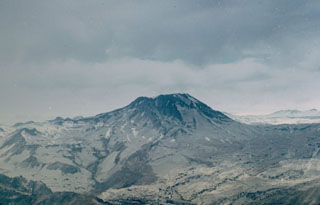Report on Descabezado Grande (Chile) — 6 March-12 March 2013
Smithsonian Institution / US Geological Survey
Weekly Volcanic Activity Report, 6 March-12 March 2013
Managing Editor: Sally Sennert.
Please cite this report as:
Global Volcanism Program, 2013. Report on Descabezado Grande (Chile) (Sennert, S, ed.). Weekly Volcanic Activity Report, 6 March-12 March 2013. Smithsonian Institution and US Geological Survey.
Descabezado Grande
Chile
35.58°S, 70.75°W; summit elev. 3953 m
All times are local (unless otherwise noted)
OVDAS-SERNAGEOMIN reported that during 1-28 February seismicity increased at Descabezado Grande, in the Laguna del Maule volcanic complex area. There were 127 earthquakes detected, with magnitudes 1.7 or less, mostly comprised of volcano-tectonic earthquakes. The seismic swarms were associated with deformation and considered to be at a high level. On 8 March the Alert Level was raised to Yellow.
Geological Summary. Volcán Descabezado Grande is a late-Pleistocene to Holocene andesitic-to-rhyodacitic stratovolcano with a 1.4-km-wide ice-filled summit crater. It lies at the center of a 20 x 30 km volcanic complex, 7 km N of the Cerro Azul stratovolcano. A lateral crater, which formed on the upper NNE flank in 1932 shortly after the end of the major 1932 eruption from nearby Quizapu cone on the N flank of Cerro Azul, was the site of the only recorded eruption. The Holocene Alto de las Mulas fissure on the lower NW flank produced young rhyodacitic lava flows. Numerous small late-Pleistocene to Holocene volcanic centers are located N of the volcano. The northernmost of these, Lengua de Vulcano (or Mondaca), produced a very youthful rhyodacitic lava flow that dammed the Río Lentué.
Source: Servicio Nacional de Geología y Minería (SERNAGEOMIN)

